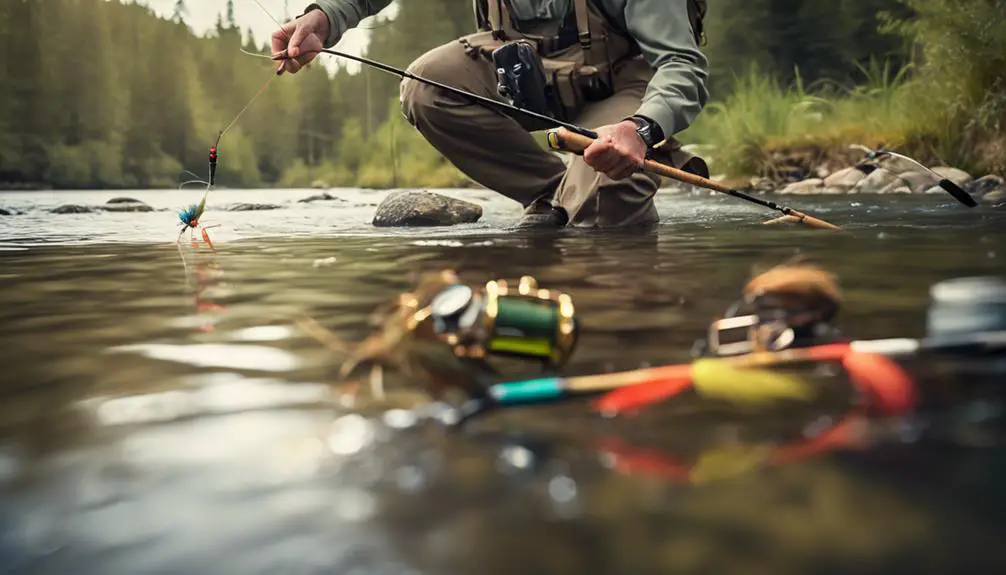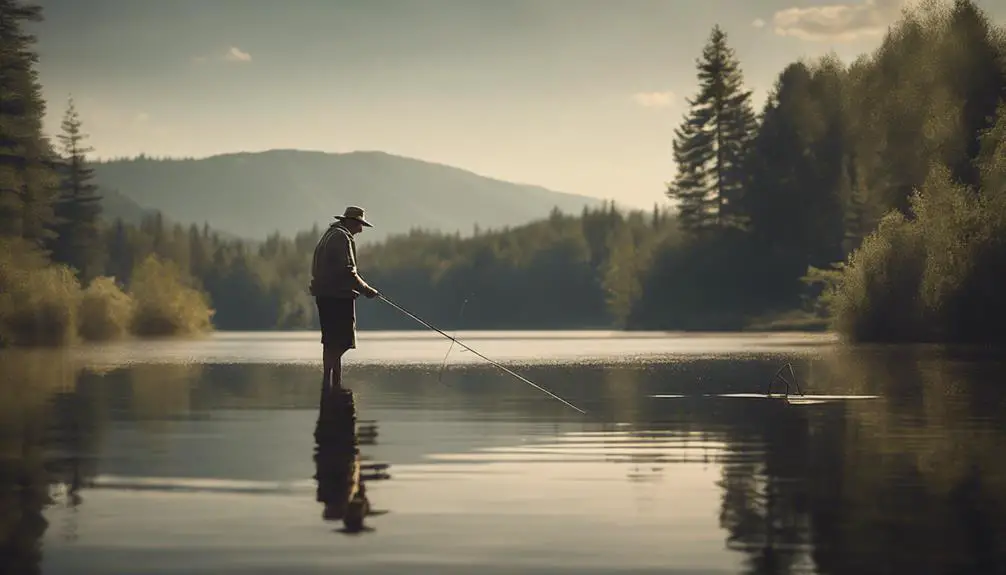
Trout fly fishing involves mastering various techniques. Dry fly fishing mimics surface insects with buoyant flies and demands precise casting.
Nymph fishing imitates aquatic insects with weighted flies to target subsurface trout, requiring a deep understanding of water columns.
Streamer fishing entices aggressive trout with lifelike motion from larger prey imitations.
Wet fly fishing focuses on subsurface flies in fast-moving waters, requiring accurate drift techniques.
Euro nymphing utilizes tight-line methods with weighted flies near the riverbed, enhancing sensitivity to subtle bites.
To delve deeper into these strategies, explore the detailed elements further.
Dry Fly Fishing
Dry fly fishing is all about using delicate, floaty flies to trick trout into mistaking them for real insects on the water's surface. Trout have a habit of snacking on insects that make that error, making this a clever strategy. The key lies in how you present your fly – it should gently plop down and drift naturally to attract those cunning trout.
Your finesse in casting plays a crucial role in delicately placing the fly precisely where it needs to be. Additionally, understanding the types of insects buzzing around is essential. Matching your fly to the prevalent bugs can significantly impact your success.
When engaging in the art of dry fly fishing, you're essentially tapping into nature's playbook. It's more than just catching fish; it involves comprehending the intricate dance between insects and water, syncing with that rhythm. Witnessing a trout rise to take a bite at your fly brings a unique thrill, blending skill, patience, and a bit of luck into one beautiful moment.
Nymph Fishing
Nymph fishing is all about using subsurface flies to mimic the young stages of aquatic insects. This method works well because trout tend to feed beneath the water's surface. To excel at nymph fishing, you need a good grasp of the water column and trout behavior. It's essential to choose nymph patterns that closely resemble the local insect population to entice the trout effectively.
Weighted nymphs, often paired with indicators, help you control the depth of your fly. Achieving the right drift and making subtle movements are crucial since trout can be picky and cautious. Becoming a master at nymph fishing requires patience and keen observation, but the payoffs can be significant.
Streamer Fishing
Streamer fishing is all about targeting those aggressive trout that are looking for a big meal. Instead of focusing on tiny bugs underwater like nymph fishing, streamer fishing imitates larger prey such as baitfish and leeches. To get those trout to strike, you'll need to be more active, casting out your fly and then stripping it back in to create realistic movements that mimic live prey.
These bigger flies, or streamers, are designed to be more visible and eye-catching, making them perfect for fishing in murky or fast-moving waters. To cast these hefty flies effectively, anglers often use heavier rods and lines.
Using streamers can result in some heart-pounding catches, as they tend to attract the larger, more predatory trout in the area. If you're looking for a lively and engaging fishing experience that combines skill and strategy, streamer fishing is the way to go. It's a great way to bond with fellow anglers and share in the excitement of hooking into some feisty trout.
Wet Fly Fishing
Wet fly fishing is all about presenting subsurface flies that mimic aquatic insects in their nymph or emergent stages. This method works wonders in fast-moving waters where hungry trout are on the prowl. By letting the fly drift naturally with the current, you can replicate the movement of real insects. The key to success lies in choosing the right fly patterns, nailing the drift technique, and adjusting leader lengths accordingly.
When it comes to fly patterns, it's crucial to pick ones that closely resemble the local aquatic insects. This high-level attention to detail can make all the difference in enticing those elusive trout. Letting your fly move with the current in a natural way is absolutely critical. This mimics the behavior of real insects and increases your chances of a successful catch. Don't overlook the importance of adjusting the leader length based on factors like water depth and flow speed. Finding the right balance here can significantly impact your fishing experience.
Mastering these key elements not only enhances your own fishing skills but also builds a sense of camaraderie among anglers. Sharing tips and tricks related to wet fly fishing can create a community where everyone benefits from each other's successes.
Euro Nymphing
Want to step up your fly fishing game? Euro Nymphing is the way to go!
This technique is all about getting those weighted nymphs right where the trout are – close to the riverbed. Forget about traditional fly lines; with Euro Nymphing, you'll be using long, lightweight rods and specialized leaders for a super sensitive setup that can sense even the tiniest nibble.
The magic of Euro Nymphing lies in the weighted nymphs. These bad boys sink fast and stay low, perfect for tempting hungry trout. Combine that with the tight-line technique, which keeps you in direct touch with your flies, and you've got yourself a recipe for detecting those subtle bites like a pro.
And don't forget high-sticking – it's all about keeping that rod tip up high to minimize drag and give you better control in swift currents.
Fishermen who swear by Euro Nymphing often find themselves reeling in more catches and feeling more connected to the river environment.
Give it a try, and you might just find yourself hooked on this highly effective and engaging style of fishing!
Frequently Asked Questions
What Is the Best Time of Day to Fish for Trout?
The best time to catch trout is usually early in the morning or late in the evening. This is when trout are most active and tend to feed closer to the surface. Additionally, the water temperatures are cooler during these times, creating optimal conditions for a successful fishing experience.
How Do Water Temperature Changes Affect Trout Behavior?
Water temperature plays a significant role in determining how trout behave. When the water is between 50-60°F, trout are more active and engage in feeding more readily. However, if the temperature rises above 70°F, it can cause stress to the trout, leading to a decrease in their activity levels. By understanding these temperature variations, anglers can enhance their fishing experience by targeting trout during their peak activity periods.
What Are the Essential Gear Items for a Beginner Fly Fisher?
If you're just starting out with fly fishing, there are a few essential gear items you'll need to get started. First off, make sure you have a good quality fly rod and reel. These are the tools that will help you cast your line and reel in those beautiful fish.
Next, you'll need appropriate fly line, leader, and tippet. These are the connections between your fly and your rod that are crucial for a successful fishing experience. Don't forget to pack a selection of flies as well. Different types of flies mimic different insects, so having a variety will increase your chances of catching fish.
To stay comfortable and dry while you're fishing, invest in a pair of waders. These waterproof pants will keep you dry when wading into the water. You'll also need a vest or pack to hold all your gear and keep everything organized and within reach.
Lastly, don't overlook the importance of basic tools like nippers and forceps. These tools will help you handle your flies and make any necessary adjustments while you're out on the water. With these essential gear items in your arsenal, you'll be well-equipped to start your fly fishing journey.
How Can I Identify the Different Types of Trout in a Stream?
When you're trying to identify different types of trout in a stream, take a close look at their coloration, patterns, and physical characteristics. For example, rainbow trout typically have a distinctive pink stripe running along their bodies, making them easily recognizable. On the other hand, brown trout are known for their golden hue and dark spots that adorn their scales.
What Are Some Effective Fly Fishing Knots Every Angler Should Know?
If you're into fly fishing, knowing a few key knots can make all the difference in your angling game. The Improved Clinch Knot, Palomar Knot, and Loop Knot are must-haves in your knot-tying arsenal. These knots are not just helpful; they're essential for securing your line and ensuring a successful catch in the angling world.
The Improved Clinch Knot is a reliable choice for attaching your fly to the tippet. It's easy to tie and incredibly strong, giving you the confidence you need when reeling in your prize catch. The Palomar Knot is another go-to knot, known for its simplicity and strength. This knot excels in securing hooks and lures, making it a favorite among anglers for its efficiency and reliability.
When it comes to creating a secure loop for your fly line, the Loop Knot is the way to go. This knot allows your fly to move more naturally in the water, increasing your chances of enticing that elusive trout. Mastering these knots not only improves your success rate but also connects you with a community of passionate anglers who appreciate the art of knot tying and fishing techniques.
Conclusion
In conclusion, dry fly fishing, nymph fishing, streamer fishing, wet fly fishing, and Euro nymphing all have their own strengths and applications when it comes to catching trout. Mastering these techniques can significantly improve your chances of success by allowing you to adapt to different water conditions and trout behaviors.
Understanding the nuances of each method helps you choose the best approach, ultimately enhancing your fishing experience and increasing your chances of landing a prized catch.
- Discover the 4 Must-Have Camping Tent Accessories for Spring 2025 - March 19, 2025
- Why Camping Is Bad - November 29, 2024
- Best Camping Knife - November 29, 2024






